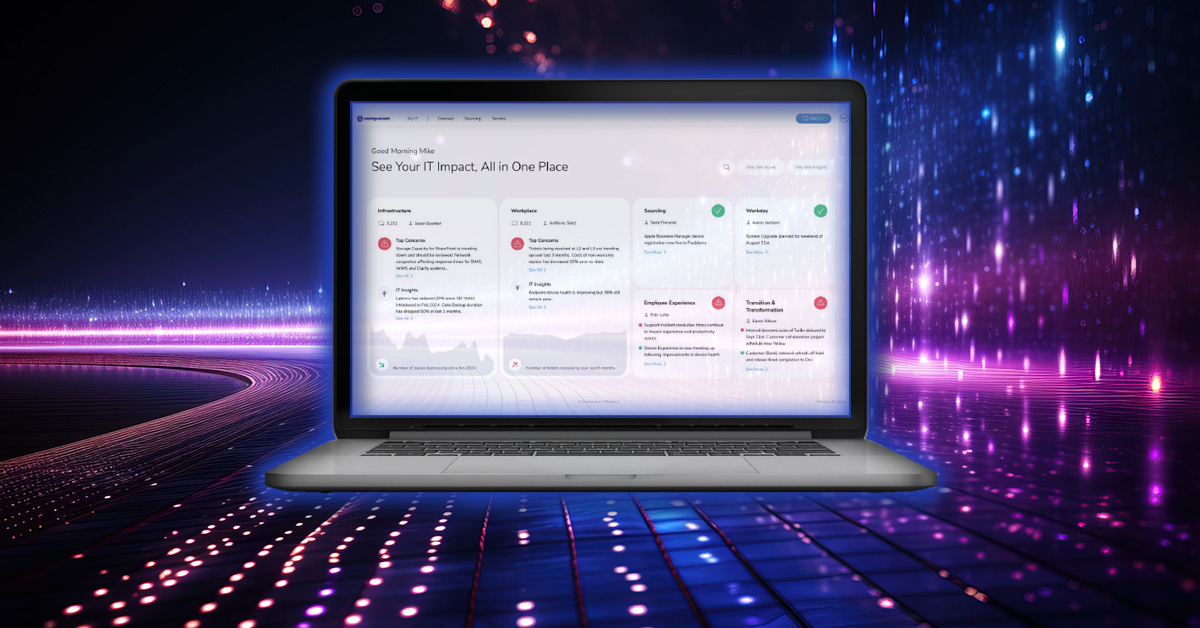- Managed Services and IT Support
- DEX

To understand why measuring and managing experience is so important, look to the watermelon.
Smooth, bright green, and gleaming on the outside. Cut it open and look inside? Red all the way through. While that’s ideal for a summer picnic, it’s the opposite of what you want in your organization!
“The watermelon effect” is what happens when service metrics appear to be “green” and on target, yet underneath the surface, it’s all red—indicating poor service and unhappy people. A customer experience nightmare.
What Causes the Watermelon Effect?
The “watermelon effect” isn’t unique to IT; it happens across all kinds of industries and organizations. This pesky problem can crop up for a few reasons:
- Not measuring the right things: You may be gathering data, but that doesn’t mean it’s telling you the right story. The watermelon effect can happen when tracking irrelevant metrics, or when your metrics completely ignore the end-user perspective (for example, focusing on volume rather than outcome).
- Not measuring experience enough or at all: Some companies still aren’t prioritizing experience. A survey by IDC found that while 81% of companies listen to customers about their experiences, nearly 70% do not measure the employee experience!
- Not empowering feedback: If your company culture doesn’t empower employees or customers to speak up or share feedback, you’ll have a harder time gathering meaningful experience data.
When it comes to managed IT service, we often apply this concept while comparing the impact of service level agreements (SLAs) versus experience level agreements (XLAs).
Measuring the Workplace Tech Experience
SLAs are an important part of managed IT service: a straightforward document holding service providers accountable to deliver to their customers. SLAs include standard requirements such as how and when the IT team responds to incidents and the expected response time for each level of service.
But too often, SLA metrics don’t reveal the true quality of your service.
Say an employee has a critical error on their corporate-owned computer while working from home. They open a service ticket from their phone and wait for help.
The service provider responds within the appropriate time frame for a “low priority” issue, troubleshoots the problem, and eventually resolves the incident by ordering a replacement. At a glance, everything appears to be going well…but it’s not.
Had anyone asked, the employee might say that they didn’t feel fulfilled by the service. They felt frustrated by the process of opening a ticket and waiting. Responses were short and rude. The employee didn’t receive tracking information for the new device and had to follow up for more information.
How could that have been avoided?
How to Prevent the Watermelon Effect
1. Understand that your SLAs should not be the only measurement of your service quality.
Clearly discuss all expectations and business goals with your service provider. Is your provider delivering continuous improvement? Are they helping you achieve your goals, or simply checking a box?
2. Consider using an XLA, which puts the focus on your people.
XLAs measure indicators of the user experience—for example, ensuring that every new hire is equipped with the right devices, software, and access on day one. An XLA can help ensure a high-quality experience every step of the way.
3. Stay nimble.
SLAs can easily become outdated over time thanks to innovations in technology or processes. Always make sure your contract includes a provision for changes and improvements.
4. Leadership can help too!
Regularly prioritize and analyze qualitative feedback and show that you’re listening to the responses. This can lead to increased trust in your business, internally and with customers.
5. Fill in the gaps.
Explore how you can incorporate other methods that take experience into account—whether that’s through NPS surveys, employee pulse surveys, or a more robust experience management platform.
Remember: when business leaders ignore valuable perspectives, problems arise undetected, and you miss opportunities to provide better service. When measuring your managed IT service, you want the real story—seeds and all.
RecenT

9 Ways Strategic IT Staffing Empowers Organizations

Case Studies: Asset Intelligence and Endpoint Compliance Made Easy

AI and the Enterprise: The Future of IT Management

Exploring the Opportunities and Obstacles of AI in the Enterprise

One Dashboard to Rule Them All: Strategic IT Excellence with Full Lifecycle Observability

Transforming IT Operations with Full Lifecycle Observability: How Compucom’s FLO Framework Redefines Data-Driven Efficiency
TOPICS
What the “Watermelon Effect” Tells Us About Experience Management
- Managed Services and IT Support
- DEX
To understand why measuring and managing experience is so important, look to the watermelon.
Smooth, bright green, and gleaming on the outside. Cut it open and look inside? Red all the way through. While that’s ideal for a summer picnic, it’s the opposite of what you want in your organization!
“The watermelon effect” is what happens when service metrics appear to be “green” and on target, yet underneath the surface, it’s all red—indicating poor service and unhappy people. A customer experience nightmare.
What Causes the Watermelon Effect?
The “watermelon effect” isn’t unique to IT; it happens across all kinds of industries and organizations. This pesky problem can crop up for a few reasons:
- Not measuring the right things: You may be gathering data, but that doesn’t mean it’s telling you the right story. The watermelon effect can happen when tracking irrelevant metrics, or when your metrics completely ignore the end-user perspective (for example, focusing on volume rather than outcome).
- Not measuring experience enough or at all: Some companies still aren’t prioritizing experience. A survey by IDC found that while 81% of companies listen to customers about their experiences, nearly 70% do not measure the employee experience!
- Not empowering feedback: If your company culture doesn’t empower employees or customers to speak up or share feedback, you’ll have a harder time gathering meaningful experience data.
When it comes to managed IT service, we often apply this concept while comparing the impact of service level agreements (SLAs) versus experience level agreements (XLAs).
Measuring the Workplace Tech Experience
SLAs are an important part of managed IT service: a straightforward document holding service providers accountable to deliver to their customers. SLAs include standard requirements such as how and when the IT team responds to incidents and the expected response time for each level of service.
But too often, SLA metrics don’t reveal the true quality of your service.
Say an employee has a critical error on their corporate-owned computer while working from home. They open a service ticket from their phone and wait for help.
The service provider responds within the appropriate time frame for a “low priority” issue, troubleshoots the problem, and eventually resolves the incident by ordering a replacement. At a glance, everything appears to be going well…but it’s not.
Had anyone asked, the employee might say that they didn’t feel fulfilled by the service. They felt frustrated by the process of opening a ticket and waiting. Responses were short and rude. The employee didn’t receive tracking information for the new device and had to follow up for more information.
How could that have been avoided?
How to Prevent the Watermelon Effect
1. Understand that your SLAs should not be the only measurement of your service quality.
Clearly discuss all expectations and business goals with your service provider. Is your provider delivering continuous improvement? Are they helping you achieve your goals, or simply checking a box?
2. Consider using an XLA, which puts the focus on your people.
XLAs measure indicators of the user experience—for example, ensuring that every new hire is equipped with the right devices, software, and access on day one. An XLA can help ensure a high-quality experience every step of the way.
3. Stay nimble.
SLAs can easily become outdated over time thanks to innovations in technology or processes. Always make sure your contract includes a provision for changes and improvements.
4. Leadership can help too!
Regularly prioritize and analyze qualitative feedback and show that you’re listening to the responses. This can lead to increased trust in your business, internally and with customers.
5. Fill in the gaps.
Explore how you can incorporate other methods that take experience into account—whether that’s through NPS surveys, employee pulse surveys, or a more robust experience management platform.
Remember: when business leaders ignore valuable perspectives, problems arise undetected, and you miss opportunities to provide better service. When measuring your managed IT service, you want the real story—seeds and all.
Recent Blogs

9 Ways Strategic IT Staffing Empowers Organizations

Case Studies: Asset Intelligence and Endpoint Compliance Made Easy

AI and the Enterprise: The Future of IT Management

Exploring the Opportunities and Obstacles of AI in the Enterprise

One Dashboard to Rule Them All: Strategic IT Excellence with Full Lifecycle Observability




